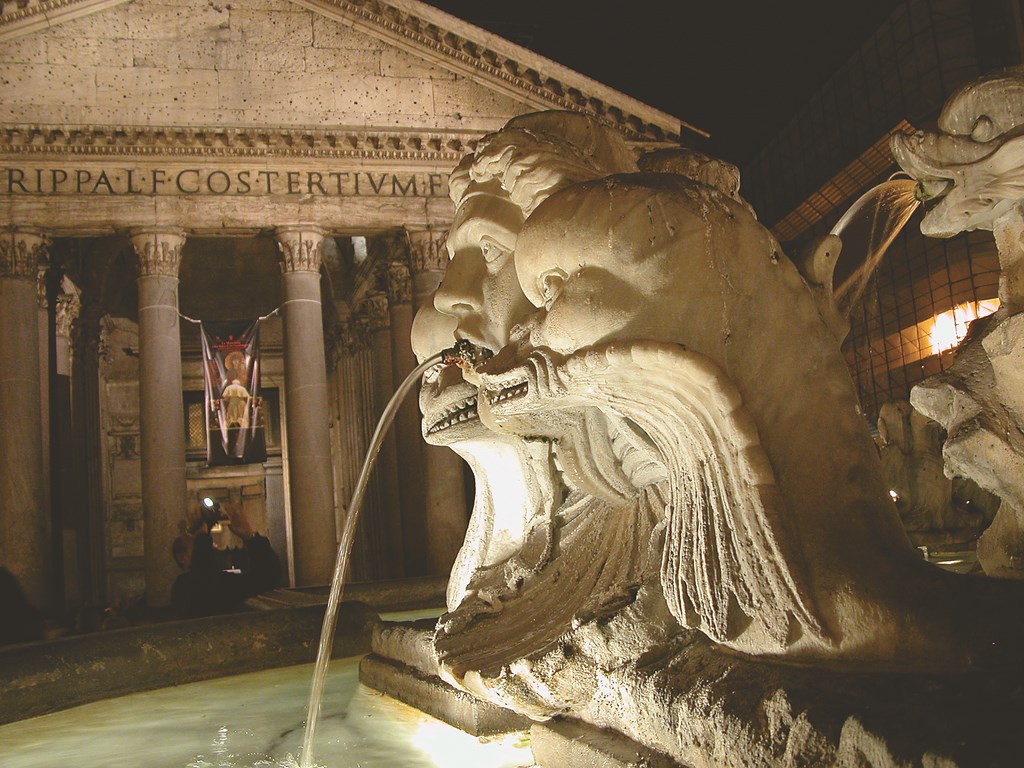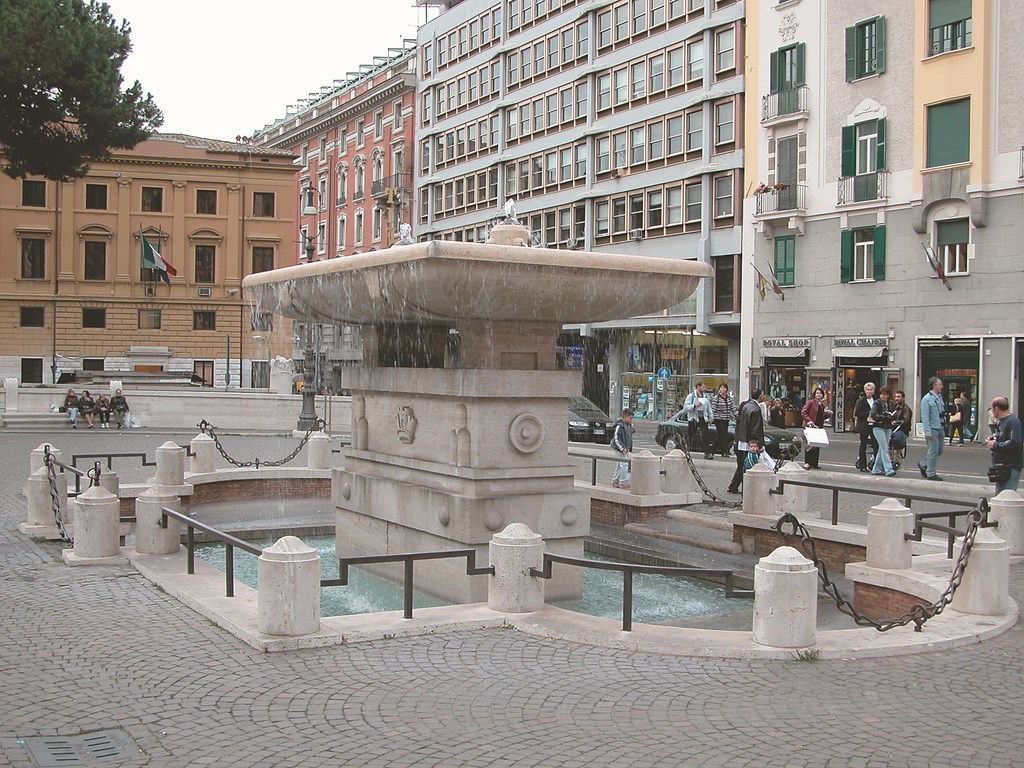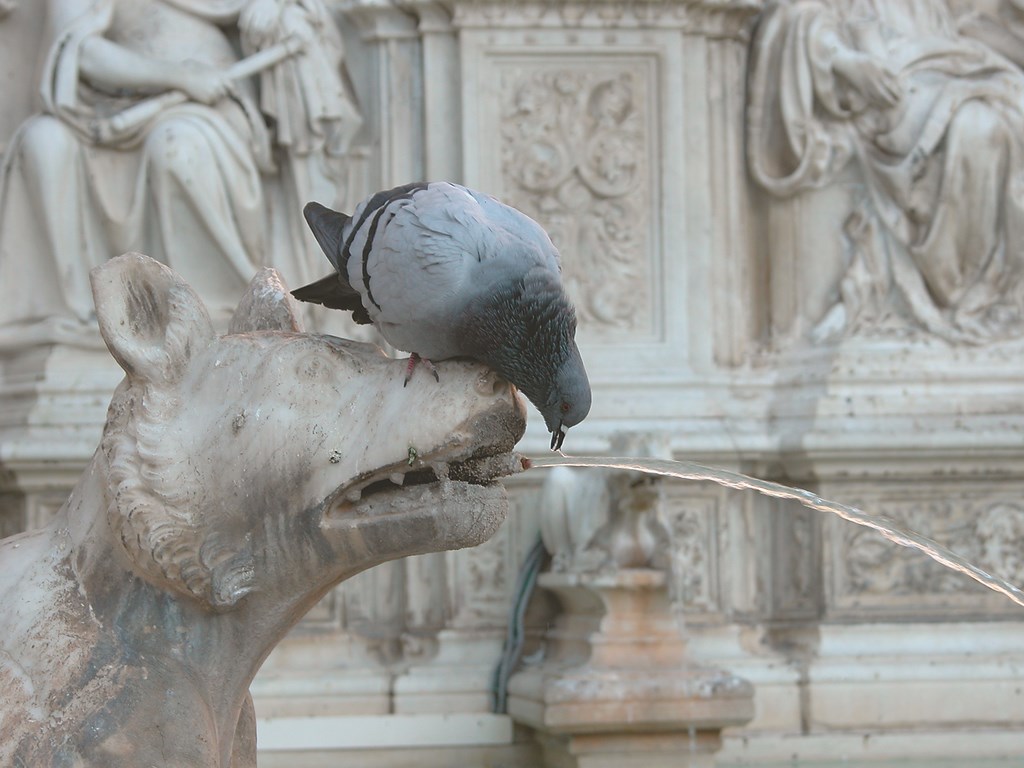Function Before Form

Have you ever wondered why watershapes are at the heart of so many venerable courtyards and plazas?
In a modern context, we might start answering that question by thinking about the natural human fascination and connection with water and then conclude that, like us, those who built the public spaces of ancient Mesopotamia or Athens or Rome simply liked being in the presence of water for emotional and spiritual reasons.
But the truth behind the prominent role of water in these spaces isn’t as romantic as all that. Indeed, there’s a far more practical answer that is easily overlooked by those who seldom need to take more than a few steps to gain access to a reliable supply of water.
The fact is, those ancient fonts and fountains in all those courtyards and plazas were once the primary method of distributing potable water. In truly ancient times, these fonts were wellheads or springs – little more than glorified hose bibs for the use of an estate or located at the center of public plazas where citizens congregated to water their horses and fill their ewers. In the centuries that followed, these spaces became grander and more elaborate, but until fairly recent times they still all served basic roles as much-needed private or public utilities.
THROUGH MODERN EYES
In the fall of 2003 and for a couple of reasons, I took a long trip to Italy. My main responsibility was teaching a class on watershaping at a design school in Tuscany. My passion during that time, however, was visiting as many old watershapes as I could with the intention of recording what I saw and using the photographs I took as teaching tools and as a resource for articles such as this one.
| The original purpose for just about any plaza or courtyard font was simple: take water from a remote source and bring it safely to where it is needed. That raw, unadorned, utilitarian function is still seen in these simple spigots, one from Siena (left), the other in Venice (right). In other examples shown in this article, this artless functionality has been wrapped in decoration from simple to sublime. |
As I traveled from town to town, I found that every major private or public space – universally – had a central core of water in the form of a fountain or wellhead. Back home, these watershapes would have been little more than eye candy in a shopping plaza or a place for kids to get wet. But here they had, for hundreds or even thousands of years, been sources of fresh water – functional utilities for their estates or towns and cultural hubs for the citizenry.
As I looked around, I gained a profound perspective on the evolution of the Western world’s branch of watershaping from its roots in the practical necessity of making water available for mass consumption all the way through to its modern expression as a form of decorative art. By trip’s end, it was easy to see why fountains, ponds and reflecting pools were so central a component in the landscapes of antiquity.
| Whatever impulse drove the ‘bulking up’ of wellheads and spigots into substantial urban structures or exactly when that transition deliberately occurred, it’s plain to see that fonts in some locations eventually came to be seen as less utilitarian, more architectural and even a bit decorative. In Bologna (left), Florence (middle) and Rome (right) among many possible examples, in fact, we see aesthetics intruding where utility had once been sufficient – but in ways that don’t compromise that utility in any way. |
This placing of water at the core of urban design dates to the foundations of our Western civilization. Consider this: Just to function at its zenith, the city of Rome needed to have 9,000,000 cubic meters of water running through its water systems at any given time – far more than the River Tiber could supply, which is why the Romans became so adept at hydraulics and developed an aqueduct system that resulted in placement of all those fonts to deliver water to all those courtyards, public squares and plazas.
As time passed, these spaces took on huge social and even political significance. They were places of commerce, congregation, contemplation and communication – a grander equivalent, in many ways, of water coolers in modern offices.
| From the Renaissance forward, Italian designers displayed a reverence for Roman mythology and imagery that worked its way into a tremendous amount of civic art, including this plaza fountain in Bologna (left). The fountain statuary’s celebration of the human form may seem a bit outrageous by modern American standards (right), but these symbols of fertility and fecundity were meant to express the natural riches of the city and the reliability of its water supply – a utility still served for any thirsty person who approaches the fountain. |
As I traveled, I observed how Roman and Italian artists and architects began to decorate these utilitarian spaces. Almost every one of the hundreds of waterfeatures I cataloged had the primary function of bringing water to the people, but it was easy to see how ornamentation emerged to overtake practicality in a way that influences the work many of us do today.
Whatever the shape of the space, it was water that dictated the order of things. In many instances, in fact, the decorative basins and/or statuary were added hundreds of years after the creation of the original watershape. The Trevi Fountain in Rome is a prime example of this evolution: Originally a simple outlet for the Aqua Virgo aqueduct, it has accreted statuary in stages since the days of the Roman Empire but only achieved its familiarly ornate form as recently as the 18th Century. And you need to reach all the way into the 20th Century before the fountain would lose its primary purpose as a public utility – albeit a magnificent one.
CURRENT AFFAIRS
This impulse to “dress up” water sources may fold this discussion back to our natural, modern, emotional answer to the question that kicked off this article. Water is so special a commodity that it is natural to surround it with attractive ornamentation and give symbolic nods to our connection to life’s essence.
| There have been occasions in Italian architecture and design where the need to water livestock and supply potable water took a clear backseat to decorative impulses – none more obvious or elaborate than Villa d’Este, the private residence of a powerful 16th-century Cardinal that stands as a fantastical expression of the potential water has to decorate and shape open spaces (left). If there is any functionality here, it is masked rather completely by a sense of water that is excessively and exclusively on display (right). |
But there’s something else at work that isn’t terribly spiritual: The ability to supply water, to bring it where it was needed (rather than making citizens take their buckets to rivers and streams) is a profound statement of power – not only for the Roman Empire and the builders of the aqueducts but also for the Renaissance princes who fortified their city/states and provided their citizens with the water they needed to survive and thrive.
Those same princes and powerful elites extended the metaphor of power to their private estates, villas and residences, showing anyone who approached that they, on a personal level, had the power to bring water where they wanted it to be rather than live at the unpredictable will or whim of nature.
|
A Trip for the Eyes My primary reason for traveling to Italy was work: teaching a class at the Santa Chiara Design School in Castiglion Fiorentino. The school is a haven for students and teachers from several American universities whose interests cross many design disciplines. I had been asked to expound on the role of water in environmental design – and where better to do it than in Tuscany? The Tuscan countryside truly is amazing. While it is superficially similar to California and specifically to California’s Central Coast region, there’s a consistency to the beauty here that enriches the experience and makes so many of the settings unrivalled and unforgettable. The most striking feature of the rolling hills is the number of hilltop castles around which so many of the Tuscan cities have grown. The stone, brick, wooden and plastered buildings of these towns are arranged in patterns around central cores – most of which, I might add, are piazzas that still have their decorative wellheads or ornate fountains, mostly in good working order. — M.H. |
This all may be difficult for us to comprehend in America, where our oldest cities are just a few centuries old and urban centers grew up with the benefit of long-established water-distribution practices. The watershapes I saw were many times older than that and were mostly still functional (in many cases with a great deal of maintenance and reconstruction).
If you strip away all the ornamentation from Roman and Italian fountains (and there are still plenty of fonts that have a plain, functional appearance, as some of the photographs seen here testify) and reconstruct the history and evolution of those watershapes, it’s plain to see that “function” preceded “form” – and that this concept has been all but lost in today’s urban watershapes.
Once modern infrastructure robbed them of their ancient purpose, watershapes in public spaces morphed into a form of public entertainment as purely decorative marvels. While there’s a well, cistern, spring or basin buried somewhere beneath the vast majority of Roman or Italian fountains in courtyards or plazas, very few American fountains have such practical underpinnings.
| Rome was and is Italy’s wellspring of power, administration and civic development, and the full range of possible outlets for water can be found around the city, from the simplest (as seen in the second photo gallery above) to the most elaborate. This control of water, a hallmark of Imperial Rome’s technology and enterprise, was tightly embraced by Renaissance princes and popes who wanted to associate with a glorious past. A case in point is this fountain sculpture, where the top draws on ancient myth (left) but the support structure below the shell is emblazoned with the papal crest and symbols of the powerful Barberini family (middle left). Elsewhere in Rome, even the plainer fonts take on a large scale and have aspirations to monumentality – but still retain a clear sense of functionality (middle right and right). |
In modern times, we’ve taken our drinking water and funneled it though a series of hidden pipes, filters and sanitizing units. For the most part, even pool hydraulics are hidden behind walls five feet tall. Rather than celebrate the way these systems work, we have systematically hidden them – and have been heading in that direction for centuries beyond count.
FINDING INSPIRATION
What endures is the water itself. Even seen in purely decorative terms, it still commands attention in exterior spaces, just as a vase of cut flowers will make a strong interior statement at key household intersections. Both reside at the crux of a critical axis, and both limit our ability to walk or reside or intrude on that key intersection. In other words, the water has always been the key – and more important than any individual in the history of design, including all of us.
| No matter how humble or grand a water source might be, it’s refreshing to be reminded that fresh, potable water in any form is a good thing, even for pigeons (N). In fact, we should stand in awe of those who moved water across Italy in days long past, sometimes over great distances, to places where it is needed. Water is indeed a tremendous civilizing force, and we as watershapers, whether we appreciate it or not, stand in the tradition of those who made possible the emergence and growth of cities as centers of population and power. |
I’ve often seen it written in the pages of WaterShapes that travel serves a vital role in broadening our perspectives and opening our eyes to alternative worlds of ideas and inspiration. I may even have done so myself on a couple of occasions, but the fact that it’s not an original idea with this article does nothing to diminish the importance of the concept.
I have been fortunate in my formal and extended education and in my affiliation with a range of creative people within the trades to be able to pursue my interest in understanding the origins of watershapes and watershaping. I have seen this as a means of elevating my own performance, and I have come to believe as well that a basic understanding of this long, ancient and honorable heritage is one of the keys to elevating both our art and our industry.
Mark Holden is a landscape architect, pool contractor and teacher who owns and operates Holdenwater, a design/build/consulting firm based in Fullerton, Calif., and is founder of Artistic Resources & Training, a school for watershape designers and builders. He may be reached via e-mail at mark@waterarchitecture.com.
























